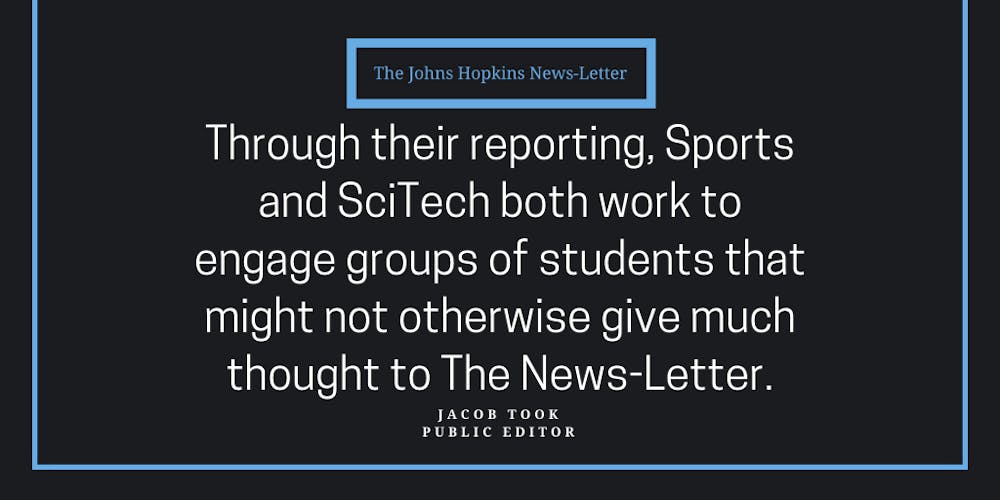
As the Public Editor, I scrutinize the ways the paper represents its readers. The News-Letter is a campus newspaper, and undergraduate students make up the primary readership. I think a lot about the different types of undergrads that the paper represents, as well as who is most likely to pick up a fresh issue on a Thursday afternoon.
All the sections do their part to represent undergrads, both through writers and through reporting. But two sections strive to include unique perspectives that don’t appear as often throughout the rest of the paper. Sports features student athletes, a small wedge of the student body, but one which no other section represents as intentionally. Similarly, Science & Technology (SciTech) uniquely focuses on STEM students in a way other sections do not.
I talked to editors from Sports and SciTech to learn more about the challenges of representing these students with such a laser focus.
For Sports Editor Matthew Ritchie, who plays baseball for the Blue Jays, highlighting the successes of student athletes in the section counters the sports culture (or lack thereof) at Hopkins. Most undergrads, he said, might not even know the school has a volleyball team, much less that they just finished an undefeated season.
Even recaps — which typically run through a game’s highlights and feature comments from at least one team member who was on the field — share updates about the latest big wins from badass Blue Jays to the paper’s entire readership. In Ritchie’s experience, the players are excited to read coverage.
“Our sports teams are really good,” he told me over Brody’s late afternoon hubbub. “It’s good [for student athletes] to know that people read the articles and that people are paying attention to how successful they are.”
With the good comes the bad, though — teams lose, and that doesn’t change Ritchie’s role. Getting quotes after a loss can be tough, he said, but he and the other editors tap into friend networks on the different teams to rustle something up. Win or lose, coverage that keeps undergrads up to date with the Jays can foster pride in our sports teams and bring more undergrads together to share in bolstered school spirit.
In addition, being an athlete is a huge and physically demanding commitment that warrants recognition. Ritchie said that student athletes can often be put in a box defined by stigmas or assumptions that other students might hold. By highlighting their voices in his reporting, Ritchie hopes that more readers will relate to the players as students.
“We’re representing them as student athletes, not athlete students,” he said. “It’s good to give them an actual voice, like, ‘Hey, we’re real people and not just athletes.’”
SciTech Editor Trisha Parayil said that researchers, like student athletes, are excited to share their voices with the paper’s student readership, particularly for coverage that spotlights the badass medical innovations or groundbreaking research coming out of Hopkins.
For this week, she interviewed Radamés J.B. Cordero, a research associate in Molecular Microbiology and Immunology at Bloomberg, who plans to learn more about how melanin absorbs radiation by sending a pigment sample into space. Despite having done interviews for other outlets, he spent 45 minutes discussing the research with Parayil.
“When we say that we’re a student newspaper, they’re even more willing to talk,” she said. “All the professors that we’ve talked to value the fact that we’re trying to bring their work to students in a digestible way.”
Parayil and her co-editor Laura Wadsten have piloted a distinct shift away from national science news to more local coverage this year.
“Shifting that focus to Hopkins science news automatically brings in a lot of people that were otherwise not being approached by The News-Letter,” Wadsten said. “If there isn’t content that you can relate to and that seems relevant to you, then you’re less likely to pick up the paper.”
Through their reporting, Sports and SciTech both work to engage groups of students that might not otherwise give much thought to The News-Letter. In SciTech’s case, the section builds on the natural STEM community on campus, while Sports can help build a stronger culture around Hopkins athletics.
But both sections feature more than just reporting — Wadsten and Parayil curate columns, in which their writers share their own perspectives as STEM students, while Ritchie and his co-editors publish ‘sportpinions,’ in which writers share their opinions about local, national and international sports stories.
In both cases, the editors told me that ideas for these pieces almost always come from writers. They do minimal edits to preserve the authenticity of these perspectives.
“If it’s a sensitive area, we’ve got to make sure that what they’re saying isn’t offensive in any sort of way, but we usually don’t want to change the whole face of an article, because that’s their voice,” Ritchie said.
But how can more flexible content let editors feature a broader range of voices? Sports does Athlete of the Week, which focuses largely on the spotlighted player’s game performances, but could they publish a “Meet the Team” column that tells readers more about the daily lives and unique challenges of student athletes? And players may not typically have time to write a piece, but broadly-reported features have the power to bring many voices together. This type of content could help readers understand student athletes better as students first.
Parayil and Wadsten have also looked to feature a more diverse range of STEM students, particularly those in engineering. As editors, they look to cover more engineering events and spotlight more research going on in engineering labs.
Could they also make use of creative columns to address the shortage of engineering perspectives — why not spotlight engineering labs or find ways to work more engineering students into reported pieces? On the other hand, both editors are keen to maintain coverage of the social sciences, which Wadsten (a Medicine, Science and the Humanities major) said can feel disconnected from the wider STEM community. Highlighting students in the social sciences, engineering and everything in between will help the paper better represent its readership.
Sports and SciTech both do a lot of work to reflect reader voices that don’t get the same intentional platform elsewhere in the paper. That’s not to discredit the other sections, which have their own roles to play representing undergrads. But the narrow focus of Sports and SciTech helps to broaden the paper’s overall readership. This year’s editors have worked to strengthen each section’s coverage, and bringing a consistent intentionality to that role lets readers from otherwise underrepresented wedges of the student body see that the paper takes their voices seriously.
We want you to be part of this conversation! We encourage our readers to email publiceditor@jhunewsletter.com with questions or comments about our practices and published content.





